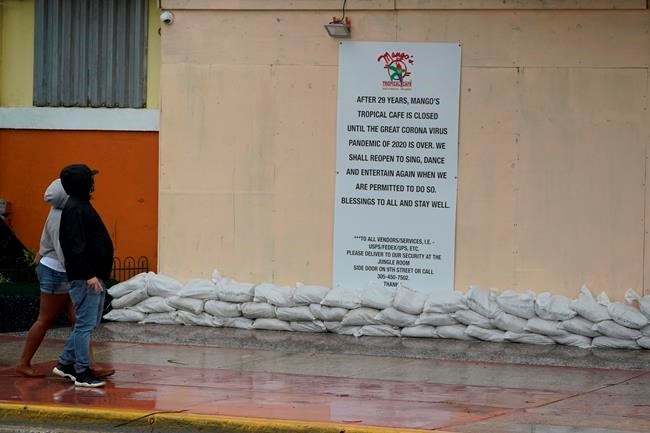HAVANA — A strengthening Tropical Storm Eta made landfall on Florida's Lower Matecumbe Key on Sunday night, days after leaving scores of dead and over 100 missing in Mexico and Central America.
The U.S. National Hurricane Center in Miami declared hurricane and storm surge warnings for the Keys from Ocean Reef to the Dry Tortugas, including Florida Bay.
Florida officials closed beaches, ports and COVID testing sites, shut down public transportation and urged residents to stay off the street. Several shelters also opened in Miami and the Florida Keys for residents in mobile homes and low lying areas. Broward County also shut down in-person schooling Monday and Miami seemed poised to do the same.
On Sunday night, authorities in Lauderhill, Florida, responded to a report of a car that had driven into a canal. Photos taken by fire units on the scene about 30 miles (48
Firefighters pulled one person from a car and took the patient to a hospital in critical condition, according to a statement from Lauderhill Fire's public information officer. Responders were continuing to search for others.
Eta had maximum sustained winds of 65 mph (100 kph) on Sunday night and was
The storm swelled rivers and flooded coastal zones in Cuba, where 25,000 had been evacuated. But there were no reports of deaths.
Eta earlier hit Cuba even as searchers in Guatemala were still digging for people believed buried by a massive, rain-fueled landslide. Authorities on Sunday raised the known death toll there to 27 from 15 and said more than 100 were missing in Guatemala, many of them in the landslide in San Cristobal Verapaz.
Some 60,000 people had been evacuated in Guatemala.
At least 20 people also were reported dead in southern Mexico and local officials in Honduras reported 21, though the national disaster agency had confirmed only eight.
Pope Francis on Sunday spoke about the population of Central America, hit “by a violent hurricane, which has caused many victims and huge damage, worsened as well by the already difficult situation due to the pandemic.” Speaking to faithful gathered in St. Peter’s Square, Francis prayed that “the Lord welcome the deceased, comfort their families and sustain all those so tried, as well as all those who are doing their best to help them.”
In Florida, Gov. Ron DeSantis declared a state of emergency Saturday for eight counties at the end of the state as Eta approached, urging residents to stock up on supplies. South Florida started emptying ports and a small number of shelters opened in Miami and the Florida Keys for residents in mobile homes and low-lying areas.
Miami-Dade County declared a state of emergency Friday night and also warned a flood watch would be in effect through Tuesday night.
Further south in the Keys, officials were monitoring the storm closely, but had no plans yet to evacuate tourists or residents. They urged residents to secure their boats and encouraged visitors to consider altering plans until Eta had passed.
Eta initially hit Nicaragua as a Category 4 hurricane, and authorities from Panama to Mexico were still surveying the damages following days of torrential rains during the week.
In Guatemala, search teams first had to overcome multiple landslides and deep mud just to reach the site where officials have estimated some 150 homes were devastated.
In the worst-hit village, Quejá, at least five bodies have been pulled from the mud. The Indigenous community of about 1,200 residents consisted of simple homes of wood and tin roofs clinging to the mountainside.
Rescue workers used a helicopter to evacuate survivor Emilio Caal, who said he lost as many as 40 family members and relatives. Caal, 65, suffered a dislocated shoulder when the landslide sent rocks, trees and earth hurtling onto the home where he was about to sit down to lunch with his wife and grandchildren. Caal said he was blown several yards (meters) by the force of the slide, and that none of the others were able to get out.
“My wife is dead, my grandchildren are dead,” said Caal from a nearby hospital.
Firefighters' spokesman Ruben Tellez said at least one additional person died in Guatemala on Sunday when a small plane went down while carrying emergency supplies to the stricken area.
In
In southern Mexico, across the border from Guatemala, 20 people died as heavy rains attributed to Eta caused mudslides and swelled streams and rivers, according to Chiapas state civil
The worst incident in Mexico occurred in the mountain township of Chenalho, where 10 people were swept away by a rain-swollen stream; their bodies were later found downstream.
Flooding in the
___
Associated Press writers Kelli Kennedy in Fort Lauderdale, Florida, Marlon González in Tegucigalpa, Honduras, and Frances D’Emilio in Rome, Italy, contributed to this report.
Andrea RodríGuez, The Associated Press




